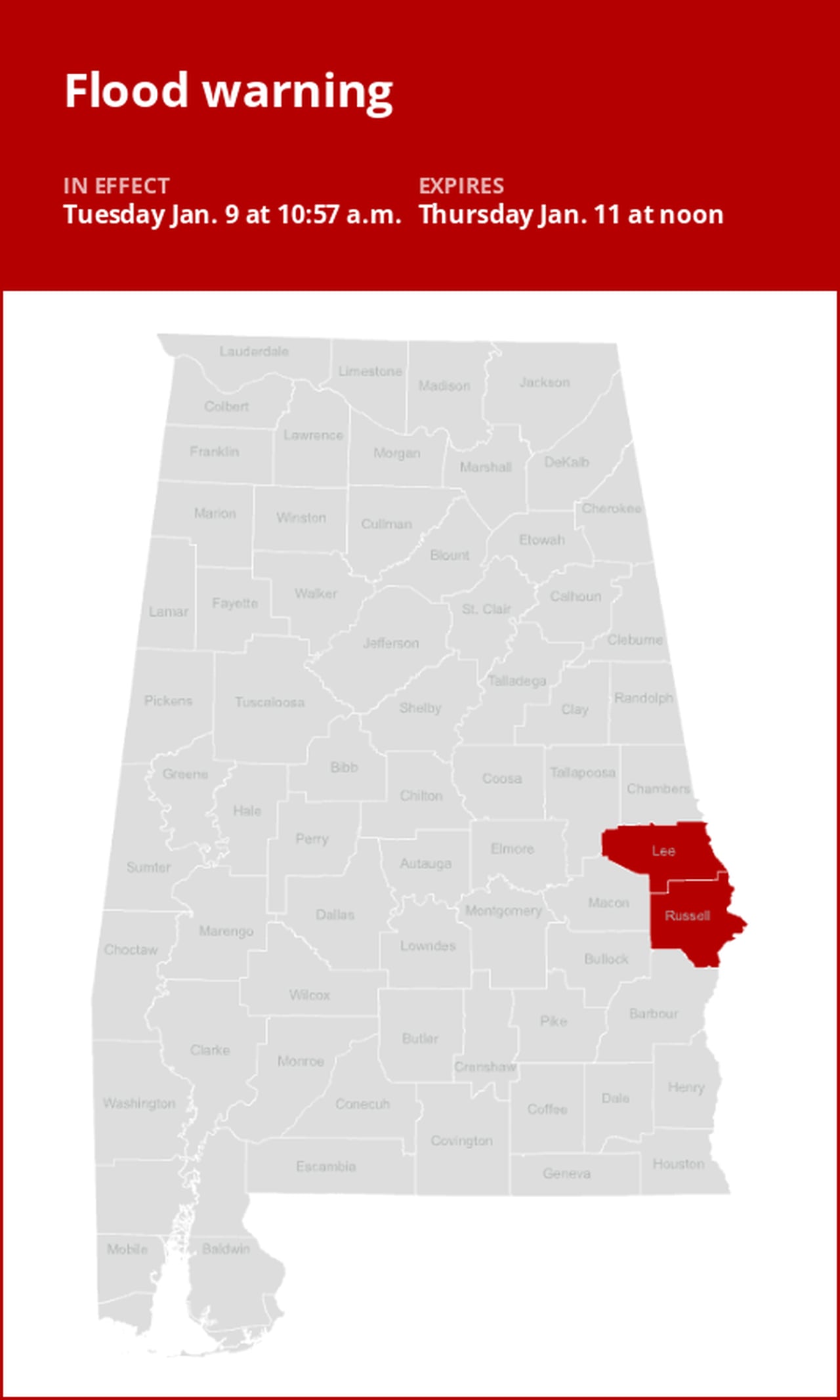Lee and Russell counties under a flood warning until Thursday midday
On Tuesday at 10:48 a.m. a flood warning was issued by the National Weather Service valid from 10 a.m. until Thursday noon for Lee and Russell counties.
The weather service describes, “Minor flooding is forecast.”
“At 28.0 feet, Minor flooding continues along the river upstream and downstream from the gage on the 14th Street bridge. Portions of the River Walk in Columbus will be flooded around one foot deep and closed to the public. The Phenix City Amphitheater on the Alabama side will begin to flood,” states the weather service.
Understanding the differences between advisories, watches, and warnings
- Flash flood warning: Take action!
A flash flood warning is issued when a flash flood is either imminent or already occurring. In flood-prone areas, it’s crucial to move immediately to higher ground. A flash flood is a sudden and violent inundation that can develop within minutes to hours, and it can even happen in areas not currently experiencing rainfall.
- Flood warning: Take action!
A flood warning is issued when flooding is imminent or occurring.
- Flood advisory: Be aware:
A flood advisory is released when flooding is not expected to reach a severity level necessitating a warning. Nonetheless, it can still cause considerable inconvenience and, without exercising caution, potentially lead to situations that threaten life and/or property.
- Flood watch: Be prepared:
A flood watch is issued when conditions are favorable for flooding. It does not mean flooding will occur, but it is possible.
When floods strike: Guidelines from the weather service for your protection
In flood-prone regions or while camping in low-lying areas, understanding and following the weather service flood safety guidelines can be a lifesaver:
1. Move to higher ground:
- If you’re in a flood-prone area, or if you’re camping in a low-lying spot, move to higher ground as a first step.
2. Follow evacuation orders:
- If local authorities issue an evacuation order, heed it promptly. Prior to leaving, secure your home by locking it.
3. Disconnect utilities and appliances:
- If time permits, disconnect your utilities and appliances. This precaution minimizes electrical hazards during flooding.
4. Avoid basements and submerged areas:
- Avoid basements or rooms submerged in water with electrical outlets or cords. Preventing electrical accidents is crucial.
5. Evacuate promptly for safety:
- If you notice sparks or hear buzzing, crackling, snapping, or popping noises, evacuate immediately. Avoid any water that may be charged with electricity.
6. Stay away from floodwaters:
- Never attempt to walk through floodwaters, even if they appear shallow. Just 6 inches of fast-moving water can forcefully sweep you off your feet.
7. Seek higher ground when trapped:
- In the event you become trapped by moving water, make your way to the highest point available and contact emergency services by calling 911.
During heavy rain, flooding is possible, especially in low-lying and flood-prone areas. Never drive through water on the road, even if it does not appear to be deep. It takes just 12 inches of rushing water to carry away most cars, according to the weather service. Stay safe by being prepared and informed.
Navigating rainy roads: Safety tips for wet weather
When heavy rain sets in, the risk of flooding and hazardous driving conditions rises. Whether it’s prolonged rainfall or rapid runoff, being prepared is essential. Here are some valuable safety tips from the weather service to ensure you stay safe in heavy rain:
Beware of swollen waterways:
- Avoid parking or walking in close proximity to culverts or drainage ditches, as the swiftly moving water during heavy rain can potentially carry you away.
Maintain safe driving distances:
- The two-second rule for following distance is your ally in heavy rain. Extend it to four seconds to ensure safe spacing in adverse conditions.
Reduce speed and drive cautiously:
- If it is raining and the roads are wet, slow down. Take your foot off the accelerator and let your speed drop gradually. Never use the brakes suddenly because this may cause the car to skid.
Choose your lane wisely:
- Stick to the middle lanes on multi-lane roads to minimize the risk of hydroplaning, as water tends to accumulate in outer lanes.
Prioritize visibility:
- Enhance your visibility in heavy rain by turning on your headlights. Watch out for vehicles in blind spots, as rain-smeared windows can obscure them.
Watch out for slippery roads:
- The first half-hour of rain is when roads are slickest due to a mix of rain, grime, and oil. Exercise heightened caution during this period.
Keep a safe distance from large vehicles:
- Large trucks and buses can reduce your visibility with tire spray. Avoid tailgating and pass them swiftly and safely.
Mind your windshield wipers:
- Overloaded wiper blades can hinder visibility. If rain severely limits your sight, pull over and wait for conditions to improve. Seek refuge at rest areas or protected spots.
- If the roadside is your only option, pull off as far as possible, preferably past the end of a guard rail, and wait until the storm passes. Keep your headlights on and turn on emergency flashers to alert other drivers of your position.
In the face of heavy rain, these precautions can make a significant difference in ensuring your safety on the road. Remember to stay informed about weather conditions and heed guidance from local authorities for a secure journey.
Advance Local Weather Alerts is a service provided by United Robots, which uses machine learning to compile the latest data from the National Weather Service.
